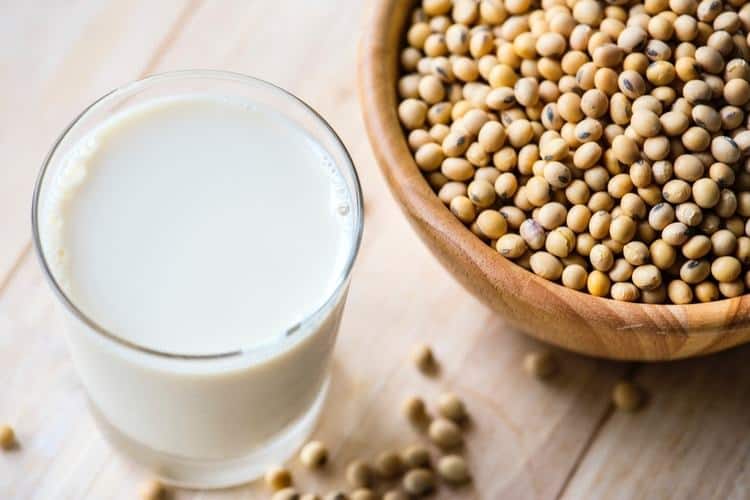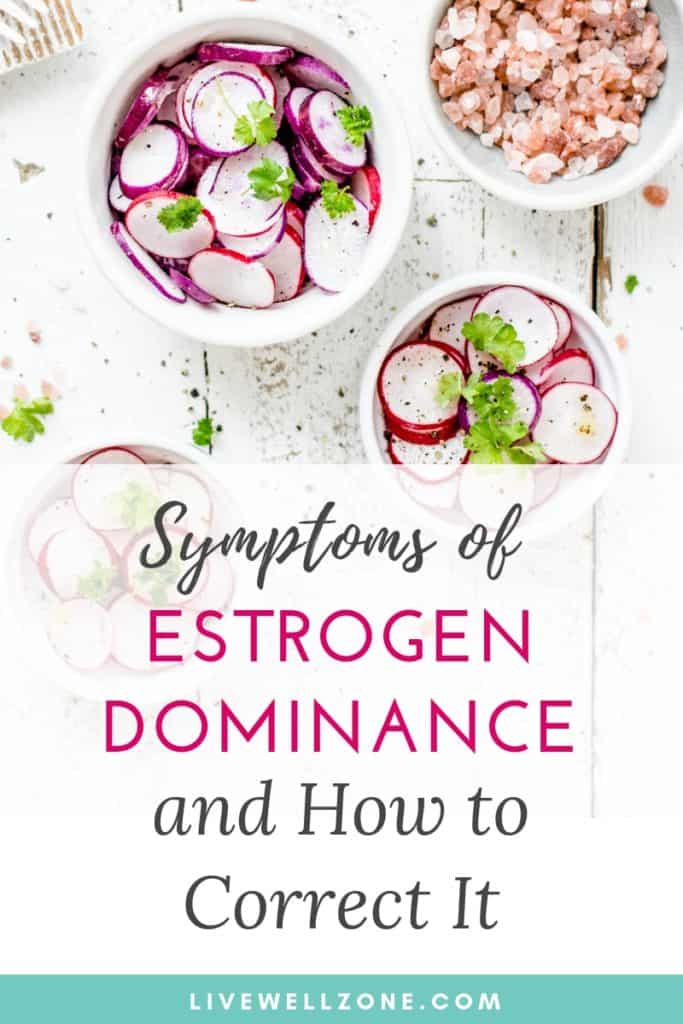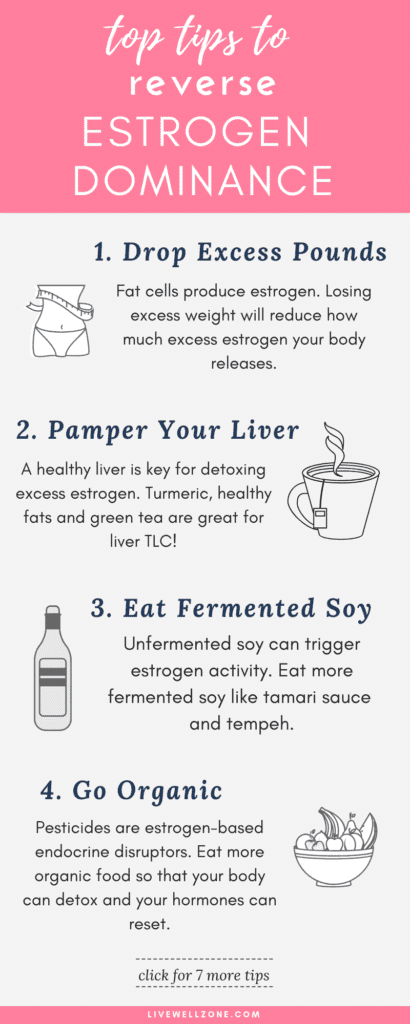
Whether it’s sleep problems, low energy, PMS or weight gain, the symptoms of estrogen dominance can be very intrusive and disruptive.
And it can be very tempting to label estrogen as “bad.”
But the truth is we really, really need estrogen…just not in high amounts.
So, to help you understand how to restore balance to your estrogen levels, this post walks you through:
- the common causes of high estrogen.
- what you can do to lower estrogen.
WHY ESTROGEN IS IMPORTANT & HOW IT WORKS
Even though estrogen is commonly known as the “female hormone,” it’s not one hormone.
Rather, estrogen is a group or family of hormones.
The 3 main forms of estrogen are:
- Estradiol
- Estrone
- Estriol
Our bodies need estrogen in order to develop (and maintain) female characteristics, as well as to (source):
- Maintain healthy bones
- Regulate menstrual cycle
- Breakdown cholesterol
- Regulate insulin sensitivity
- Ensure healthy cognitive function
- Maintain body temperature
- Regulate collagen production
…and so much more!
So, as you can see, estrogen is involved in a wide variety of critical processes that keep us looking and feeling good.
COMMON SYMPTOMS OF EXCESS ESTROGEN
As with other forms of hormone imbalance, the symptoms of high estrogen vary from one woman to another.
Having said that, some common symptoms and side effects of high estrogen are:
- PMS
- Acne
- Bloating
- Fertility problems
- PCOS
- Ovarian cysts
- Irregular menstrual cycles
- Thyroid dysfunction
- Swollen and tender breasts
- Fibroids
- Low sex drive
- Brain fog
- Fibrocystic lumps in the breasts
- Erratic sleep or insomnia
- Fatigue and exhaustion
- Endometriosis
- Depression
- Weight gain
- Mood swings
- Headaches
- Anxiety and panic attacks
- Hair loss
- Cold hands and/or feet
- Poor memory
THE TOP 10 CAUSES OF HIGH ESTROGEN LEVELS
As you’ll see in this section, estrogen dominance is heavily influenced by our diet and lifestyle.
Even though all of the items outlined in this section may not apply to you, it’s a good idea to be aware of them.
1. Personal Care And Beauty Products

The majority of personal care and beauty products contain xenoestrogens.
These xenoestrogens are hormone-disrupting chemicals that mimic your natural estrogen.
So how do xenoestrogens in personal care and beauty products enter the body?
Well, it turns out that the skin can absorb up to 70% of what we apply onto it (source).
So, if we use products that contain hormone disruptors, they can eventually make it into the bloodstream.
Some common products that are known to contain xenoestrogens include:
- Sunscreen
- Shampoo
- Body lotion
- Soap
- Shower gels
2. Pesticides and Herbicides
It’s said that in the U.S, we eat about 8 pounds of strawberries per year.
Normally, this would be a good thing for our health…
Except for this scary fact: tests done by the USDA show that strawberries have the highest levels of pesticide contamination.
In fact, some strawberry samples contain up to 22 different pesticide residues.
But it’s not just a strawberry issue.
All conventionally farmed fruits and veggies are exposed to pesticides or herbicides.
In addition, two of the most common pesticides and herbicides – glyphosate and atrazine – are estrogen-based.
This means that regular consumption of conventionally-farmed produce can contribute to elevated estrogen levels.
3. Birth Control

It used to be that birth control was used mainly as a contraceptive.
But as time has gone by, birth control has become one of the default prescriptions for “managing”
- heavy periods
- teenage acne
- menopause symptoms
- and other “female” problems
In fact, back in 2011 it was noted that about 14% of birth control prescriptions in the U.S. were for non-contraceptive reasons.
This is problematic because birth control contains estrogen.
Therefore this another way through which we’re exposed to synthetic estrogen.
4. Excess Weight
We all know that the ovaries make estrogen.
But did you know that your fat tissues also produce estrogen?
You see, estrogen and fat tissues go together like babies and pacifiers.
Here’s why:
- Fat cells contain an enzyme called aromatase.
- Aromatase is responsible for converting testosterone and progesterone into estrogen.
- The more fat cells we have in the body, the more aromatase we also have.
- And the more aromatase we have, then the more estrogen we produce.
In addition to all this, aromatase activity triggers fat storage.
Therefore, the more aromatase activity there is, then the more fat the body stores…
And the more fat you store, then the more estrogen you produce…and round and round it goes.
So, basically carrying excess weight can set you up for estrogen dominance.
And at the same time, having estrogen dominance, can worsen weight gain.
5. Unfermented Soy

Soy is the go-to food for many women who are looking to balance their hormones naturally.
The main reason why soy is regarded as a hormone-friendly food is that women in countries like Japan and China (where soy is consumed regularly), report having far less hormonal imbalance issues.
However, there is one small, but significant, detail that isn’t talked about: Asian countries consume a lot more fermented soy.
On the other hand, the U.S (and other Western countries) consume mostly unfermented soy.
So, just how much should you worry about the consumption of unfermented soy?
Well, here are 3 reasons:
- Goitrogens: Unfermented soy can have a goitrogenic effect. This means that it has the ability to disrupt the uptake of iodine, which is needed to make thyroid hormones.
- Phytoestrogens: The phytoestrogens (i.e. plant estrogens) in soy can mimic natural estrogen and possibly, create hormonal imbalance.
- Phytates: Soy contains phytates, which are compounds that prevent the absorption of minerals like magnesium, zinc, calcium and so on. Without these minerals your endocrine system, reproductive system and other systems can start to suffer.
6. Stress/Inflammation

In order to understand how stress can lead to excess estrogen, we have to talk about pregnenolone.
Pregnenolone is a hormone that the body uses to make progesterone and cortisol (the “stress” hormone).
Now, under healthy conditions, your body has enough pregnenolone to make both hormones.
However, if you’re under chronic emotional, chemical or physical stress, then:
- your body goes into a state of inflammation.
- in order to fight inflammation, your adrenals need to produce anti-inflammatory hormones (mainly cortisol).
So, what does this have to do with excess estrogen?
Well, since your body uses pregnenolone to make cortisol and progesterone, this means that your body will choose to make cortisol at the expense of progesterone.
This is worrisome because estrogen levels are measured relative to progesterone.
This means that anything that reduces progesterone levels will end up making estrogen dominant.
So, all in all, chronic stress and inflammation creates a cascade of events that affect estrogen (and progesterone) levels.
7. Unhealthy Liver
The liver is the main organ that processes all waste and toxic material.
Whether it’s pesticides, chemicals from beauty products, toxins from water, alcohol we drink…everything goes through the liver.
If the liver is not able to keep up with its normal functions, then guess what happens?
Those toxins stay in the body and create inflammation, which can raise estrogen.
8. Conventional Animal Products

193 pounds per person, per year.
That’s the amount of beef, pork and/or chicken that the average American consumes per year.
And that number was projected to increase to 222.2 pounds by the end of 2018.
That quantity of meat consumption is concerning.
Not because meat is a bad thing, but because conventional meat contains hormone-disrupting compounds.
The most important ones are:
Growth hormones
- rBGH (Recombinant Bovine Growth Hormone) is a growth hormone for cows, not humans.
- That rBGH gets into the cow’s entire system and eating beef from those cows messes with our human hormones.
Antibiotics
- All conventionally raised animals (mainly cows) are give antibiotics to prevent disease.
- Eating meat from those animals exposes you to small, regular doses of antibiotics.
- Since antibiotics ruin gut health (which is necessary for hormones regulation), your body will have a hard balancing estrogen levels.
Soy
- Soy is commonly fed to farm animals, and particularly, chickens.
- Eating meat, milk or eggs, can expose you to more soy.
- In fact, research has shown that the yolk of an egg has significant amounts of soy, compared to other parts of a chicken.
Now, before we wrap up this section, also note that farm-raised fish has also been shown to contain a wide variety of toxins.
Not just antibiotics, but also plastics, dioxins, and many more.
9. Polluted Water
As if everything we’ve looked at so far wasn’t enough, there’s also the water supply to be aware of!
There are two main sources of polluted water that most of us are exposed to: the public water supply and bottled water sold in plastic containers.
In the case of public water, contaminants such as dioxins, PCBs and pesticides have been found.
As for bottled water, the main culprit is BPA (bisphenol A).
BPA is an estrogen-based, chemical that is used to make plastics.
Research has shown that BPA can leach out of the plastic bottle and into the water that it holds.
So, what exactly can happen when we’re exposed to BPA?
Well, the sky is the limit in terms of the damage.
To quote the findings of a 2013 study:
“Long-term exposure of female mammalians to BPA can lead to endocrine disorders, followed by the morphological and functional changes in ovary, uterus, vagina, and oviducts. The interactions of BPA with various target molecules or tissues will cause different effects.”
Wow…that pretty much says everything, doesn’t it?
10. Unhealthy Gut Bacteria

Your gut contains a group of microbes known as the estrobolome.
The estrobolome is responsible for:
- metabolizing estrogen.
- regulating how much free estrogen circulates in the body.
- detoxing estrogen.
Not bad for bacteria, right? 🙂
This is another reminder that gut health is essential for good health.
TIPS FOR LOWERING YOUR ESTROGEN LEVELS
We’ve covered a lot in the previous section, most of it quite depressing.
So, let’s shift gears now and talk about what you can do to lower estrogen.
At a high level, the main things to focus on are:
- using non-toxic skincare products
- finding alternative forms of birth control
- filtering your water
- eating more whole foods (organic when possible)
- reducing consumption of animal foods (or switching to organic ones)
- managing stress
- supporting gut health
- boosting liver health
- using essential oils for estrogen dominance
Now, I know that seems like a lot, but it’s actually simple to do once you have a step-by-step breakdown of everything.
To help you get started, follow this guide on how to reverse estrogen dominance naturally.
It walks you through the supplements, foods and other steps that will help you flush out excess estrogen.
CONCLUSION
Although there are many different factors that contribute to estrogen dominance, overcoming it is about focusing on the basics: a healthy, whole food diet.
With the diet as your foundation, you can add on optional supplements, while also making sure to prioritize stress reduction.
I hope this guide was helpful and for more natural remedies to support your health, check out one the additional resources listed below.
Related Articles:
Essential Oils for Estrogen Dominance: Benefits, Best Blends + How To Use Them
How To Use Adaptogens for Estrogen Dominance Relief




